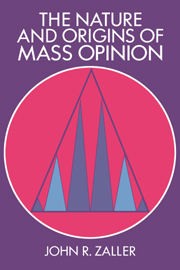Book contents
- Frontmatter
- Contents
- List of tables and figures
- Preface
- 1 Introduction: The fragmented state of opinion research
- 2 Information, predispositions, and opinion
- 3 How citizens acquire information and convert it into public opinion
- 4 Coming to terms with response instability
- 5 Making it up as you go along
- 6 The mainstream and polarization effects
- 7 Basic processes of “attitude change”
- 8 Tests of the one-message model
- 9 Two-sided information flows
- 10 Information flow and electoral choice
- 11 Evaluating the model and looking toward future research
- 12 Epilogue: The question of elite domination of public opinion
- Measures appendix
- References
- Index
10 - Information flow and electoral choice
Published online by Cambridge University Press: 05 June 2012
- Frontmatter
- Contents
- List of tables and figures
- Preface
- 1 Introduction: The fragmented state of opinion research
- 2 Information, predispositions, and opinion
- 3 How citizens acquire information and convert it into public opinion
- 4 Coming to terms with response instability
- 5 Making it up as you go along
- 6 The mainstream and polarization effects
- 7 Basic processes of “attitude change”
- 8 Tests of the one-message model
- 9 Two-sided information flows
- 10 Information flow and electoral choice
- 11 Evaluating the model and looking toward future research
- 12 Epilogue: The question of elite domination of public opinion
- Measures appendix
- References
- Index
Summary
Election campaigns are attempts by competing partisan elites to reach citizens with political communications and persuade them to a point of view. In this essential respect, election campaigns resemble the ongoing campaigns to shape public opinion that we have examined in previous chapters. One may therefore suspect that the dynamics of contested elections are much like those we have already seen. One may suspect, that is, that citizens vary in their susceptibility to influence according to their general levels of political awareness and their predispositions to accept the campaign messages they receive.
The aim of this chapter is to test this suspicion. I will examine four types of contested elections: elections for the House of Representatives and U.S. Senate, general presidential elections, and presidential primary elections. In so doing, I will try to shed light afresh on the question of how citizens choose their elected representatives. No attempt will be made, however, to develop a comprehensive account of electoral behavior in these four types of elections. Rather, my primary effort will be to use systematic differences that exist among them to increase understanding of how, in general, mass attitudes form and change in response to competing flows of political information. Capitalizing on the fact that most congressional campaigns are dominated by incumbent officeholders, I shall be especially interested in the process by which citizens resist dominant campaign messages.
- Type
- Chapter
- Information
- The Nature and Origins of Mass Opinion , pp. 216 - 264Publisher: Cambridge University PressPrint publication year: 1992



